- Ask a related questionWhat is a related question?A related question is a question created from another question. When the related question is created, it will be automatically linked to the original question.
This thread has been locked.
If you have a related question, please click the "Ask a related question" button in the top right corner. The newly created question will be automatically linked to this question.
hi team:
Can you help to promote a Amp that can satisfy with below requirement? Tks!
The reference frequency is 10MHz, and I want to find a reference amplifier that does not affect the phase noise. Reference phase noise -155dBc@10kHz offset.
Hi Allen,
You do not provide any information about the supply voltage nor circuit configuration - please click on the link below to see the list of potential parts:
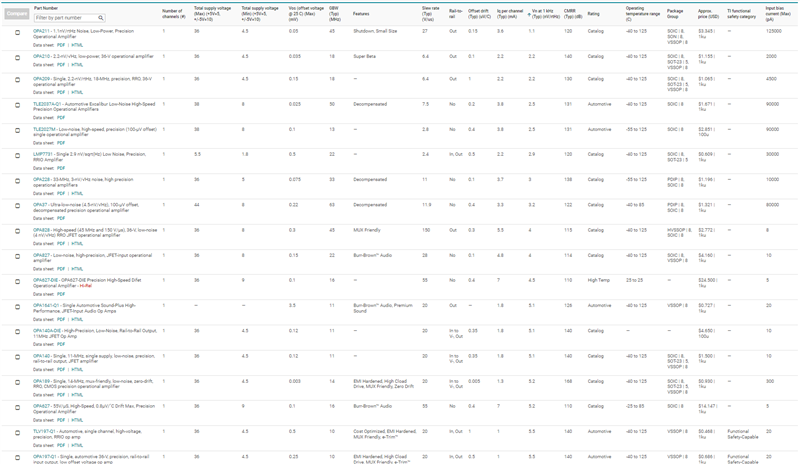
hi Marek:
my customer have a use case and want to choose a suitable Amp for this case as below green mark area. Can you help to confirm? tks !
here attached the parameter and block diagram:
1. signal input is a 0.1~ 0.6V(Vpp), typical is 0.4V, Sinusoidal signal with10Mhz.
2. the final signal will go into STuw81300 CLK device, and the input signal has the following requirements.
3. Reference phase noise -155dBc@10kHz offset.
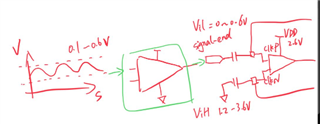
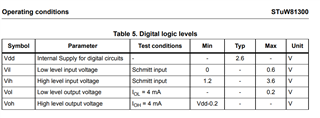

Here attached the spec of STuw81300 :
Hi Allen,
Op amps, with possibly the exception of chopper op amps, produce flicker noise often referred to as 1/f noise. An amplifier's 1/f noise will contribute to the phase noise of a signal passing through the amplifier. Chopper op amps in theory null out their 1/f noise, but our Precision Amplifiers chopper op amps don't have sufficient open-loop gain (Aol) at 10 MHz to be applicable at that reference frequency. Our Precision Amplifiers op amps are rated with a maximum gain-bandwidth (GMW) of 50 MHz, and most of them are not that high. Therefore, they don't fit well in most 10 MHz applications.
Another issue for our Precision Amplifier op amps is you show a +2.6 V supply. That supply voltage is below the minimum supply voltage rating of our higher GBW op amps.
I suggest you contact TI's High-Speed e2e and provide the application information you have provides us here in Precision Amplifiers. They have a broad op amp product line with low-noise, very high GBW op amps, some > 1 GHz. However, I believe the +2.4 V supply voltage may be an issue for those amplifiers as well. Even if there is an otherwise suitable op amp it will add to the phase noise.
Regards, Thomas
Precision Amplifiers Applications Engineering
Hi,
Opamp 1/f noise is only present at low frequencies, typically below 100Hz or so and since AC coupling is applied here, 1/f noise seems to be practically removed. I think broadband (white) noise is more limitiing in this case, therefore a narrow bandpass filter around 10MHz could reduce the noise contribution of the amplifier effectively. Probably there are formulas to calculate the phase noise of a sinusoidal signal with additive noise component.
Best wishes, Zoltan
Hi Zoltan,
I agree with you that the 1/f contribution may not be an issue a low-bandwidth op amp, but high-speed op amps can have a 1/f transition to broadband noise above 100 kHz. The Reference datasheet lists the typical phase noise at 10 MHz as -144 dBc/Hz which is quite low. The e2e post specified "I want to find a reference amplifier that does not affect the phase noise." Even though 1/f transition and the reference frequency are two decades apart it would seem that there is the possibility it could have some effect on the phase noise.
Regards, Thomas
Precision Amplifiers Applications Engineering
Adding to Thomas' comments, for a given IQ quiescent current, 1/f noise corner is the lowest in bipolar input amplifiers and highest for CMOS input while JFET input op amps fall somewhere in between - please review the app not under link below:
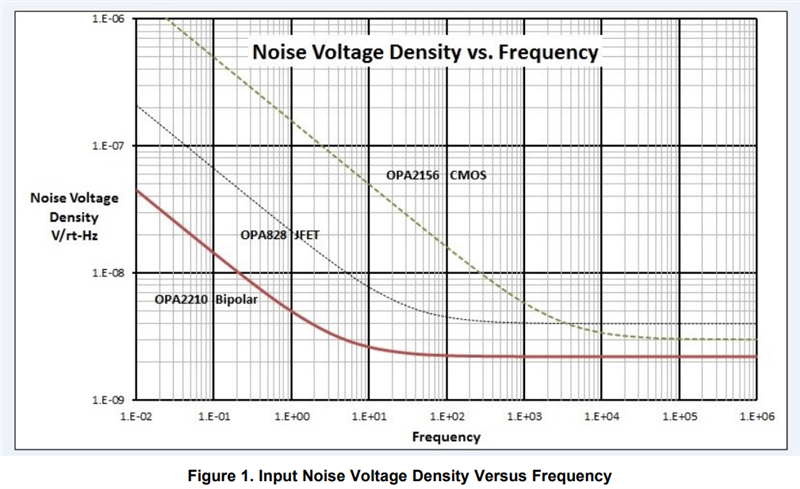
Hi,
I’ve tried to calculate the impact of an amplifier circuit with known noise specs on phase noise.
First of all, since there is no amplifier without noise, therefore it is impossible to keep the original -155dBc@10kHz value. There should be some tolerance.
To my knowledge, phase noise is defined as the noise power in 1Hz bandwidth at the offset frequency divided by the carrier’s power (and it is given in dBc). I assume that the amplifier circuit is linear, so only the noise component at this frequency (in Allen’s case 10MHz+10kHz) matters. In phase noise calculation only the noise at the offset frequency expressed in V/√Hz should be squared to get the power, since 1Hz bandwidth should be used. The signal power is 0,02V^2.
The overall value can be obtained by summing the original noise power and the amplifier circuit’s noise power.
I've made a simulation to give an example using the OPA691 low noise current feedback opamp:
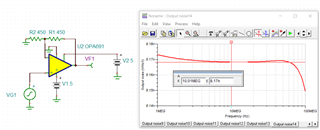
According to the simulation, the circuit's total noise at 10MHz+10kHz is 8.17nV/√Hz, so the phase noise contribution is -150.8dBc (here the signal gain is 2).Taking the original -155dBc the total phase noise is -149.4dBc.
Update: the above is a linear approximation, however, due to some nonlinearity the lower frequency noise can be upconverted. Therefore, depending on the degree of nonlinearity of the amplifier, the noise at 10kHz can limit the mentined parameter further - regardless of the type of the noise. But as Thomas and Marek shown, 1/f noise can be present at 10kHz and it is above the white noise level, so it counts more.
I’ve found a good reference at IEEE, the preprint article if freely available on arxiv (“Phase Noise in RF and Microwave Amplifiers” by Rodolphe Boudot and Enrico Rubiola).
Maybe Thomas and Marek know more about how to handle the nonliearity for determining the phase noise parameter.
It seems to me that low noise, low distortion and even the amplifier topology can all be critical.
Best wishes, Zoltan
p.s.: Thomas, would you please share the link of the e2e post you've mentioned? I've not found it.
Hello Zoltan,
Thank you for taking the phase noise analysis as far as you have. Since Marek and I cover precision amplifier having relatively low bandwidth we seldom encounter questions about phase noise. Broadband input voltage noise density (en, nV/√Hz) at 1 kHz (etc), and input voltage noise (1/f, En, µVPP) for f = 0.1 Hz to 10 Hz are the primary noises of concern in precision applications. Our High Frequency Amplifiers Applications team certainly encounters phase noise questions because that is a valid issue for some high-frequency applications.
I do think that Allen can best move his application forward by contacting the High Speed Amplifiers e2e as I suggested. Thanks again for your useful contribution to this e2e post.
Regards, Thomas
Precision Amplifiers Applications Engineering